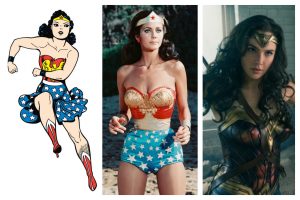Hello everyone and welcome back to my blog, I took a little bit of a break for reading week; but I’m excited to share more about this topic. If you recognized the title, then you already have an idea of what I will be talking about in this week’s blog. Today, I will be talking about the first notable woman in superhero comics.

Evolution of Wonder Woman. From Left to Right: Original 1941 release, Lynda Carter as Wonder Woman in the late 1970s TV series, and Gal Gadot as Wonder Woman in her first big-screen release.
Wonder Woman was created by psychologist William M. Marston in 1941. From her inception, she has always been a symbol for feminists across the United States, and that was intentional. Marston was a proud feminist, and that was reflected in his work. As well as the work of Harry G. Peter, the comic artist that first drew Wonder Woman. Wonder Woman’s costume is easily recognizable, with the blue skirt, bulletproof armbands, and the red and gold breastplate. This outfit reflected common themes for superhero costumes, patriotic red and blue, even if the character is not American.
Wonder Woman’s origin story is not as recognizable to a wide audience like that of Superman or Batman. Wonder Woman, or Princess Diana, comes from an island only populated by Amazonian women called Themyscira. She was created by Queen Hippolyta from clay. Diana becomes Wonder Woman after Steve Trevor crash-lands on Themyscira, and she must return to the Man’s World to spread a message of peace.
Although, not all of Wonder Woman’s history included truth lassos and warrior women. After WWII, creator Marston passed away, and Wonder Woman was given to another writer who stripped her of her powers. Her loss of powers reflected the feeling of many women, who were forced out of the working world, and back into the traditional roles of women such as babysitters, mothers, and home-makers. Instead of the powerful princess, Diana became a fashion model and a wife to Steve Trevor that gave advice to women in a newspaper column.

She remained this way for several years before Gloria Steinem placed Wonder Woman in costume on the cover of Ms. Magazine. Steinem, who grew up with the original Wonder Woman, petitioned for her return to glory. To this day, she remains the feminist icon that William Marston intended her to be. A superhero for little girls to look up to, that encouraged compassion over war.
Wonder Woman paved the way for future women superheroes. After her debut in 1941, she allowed for female superheroes like Storm, Black Widow, Killer Frost, and Captain Marvel to be created and adored by women and girls around the world.
Thanks for reading and check back next week when I’ll talk about the over-sexualization of women in comics.
Leave a Reply
You must be logged in to post a comment.